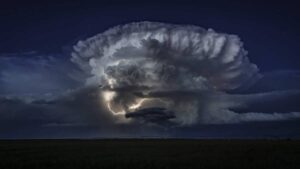American West getting ready to fire up drill rigs in blitz aimed at maiden resource at Storm copper project

Pic: Crispin la Valiente/Moment via Getty Images
American West Metals is kicking off its 2023 field season, launching an extensive 10,000m RC drilling campaign across three key prospects at the Storm copper project in Canada in a bid to deliver maiden resources.
An RC rig is being mobilised to the high priority project at Somerset Island in Nunavut, with drilling to start shortly to define a resource at the 4100N Zone.
It has already shown promise, with historical drilling striking 15m at 3.88% copper from 72.4m, 27.2m at 1.9% copper from 78.8m and 5.8m at 3.6% copper from 38.6m – widths, grades and depths that would make any explorer smile.
Resource drilling is also slated to follow at the 2750N and 2200N Zones where high grade copper has previously been identified, with a moving loop electromagnetic survey to assist targeting for both resource definition drilling and the identification of new targets.
Meanwhile, diamond drilling and ground gravity surveys have been planned to follow up a major 2022 discovery of stratabound sedimentary copper sulphides at depth.
“We are pleased to report that the mobilisation of the RC drill rig and geophysical equipment is well advanced at the Storm Copper Project in Nunavut, Canada,” American West Metals (ASX:AW1) managing director Dave O’Neill said.
“The initial phase of drilling is designed to define maiden JORC resources within the 4100N, 2750N and 2200N Zones, where high-grade copper mineralisation starts from surface.
“We believe that significant copper resources exist within these zones with excellent potential to support a low-cost, open pit style mining operation.”
Big plans ahead
More than 30 drill holes are initially planned, testing for copper between 50-150m depth owing to the shallow nature of the previously defined mineralisation at Storm.
Drilling last year highlighted the continuity of the copper zones at the project, with near-surface mineralisation a focus for drilling due to high grades, shallow hits and the potential to provide resources for a low-cost, open pit mining operation.
Previous drilling has defined high grade copper mineralisation over 40ha at Storm with an average weighted grade from 32 drill holes of 2.15% Cu and average thickness of 24m.
MLEM will follow up 11 shallow, high priority EM conductors identified in a fixed loop survey completed in the 2021 field season, some coincident with outcropping high-grade copper occurrences which remain untested.
AW1 believes the EM will outline zones with strong, more massive sulphide mineralisation to assist in prioritizing resource definition drilling.
Larger at depth?
But exploration will not be defined just to the limits of already known mineralisation.
AW1 received a sense of the potential of Storm in hole ST22-10, which suggested near-surface prospects could be related to a large, sediment-hosted copper system at depth.
Interpreted geochemical and geological data suggests the hole intersected the margins of a mineralised system.
New high resolution geophysical surveys are planned including a closely spaced ground gravity survey and moving loop EM to cover known prospects and better define the existing Falcon airborne gravity and EM targets as well as extend into previously untested areas to expand the footprint of copper mineralisation.
New areas include the Blizzard, Tornado and Tempest prospects, the latter around 40km south of Storm with a large 250m-plus copper gossan exposed at surface with rock chip samples of up to 32% copper.
Diamond drilling will be used to test high-priority exploration targets and is expected to start after resource drilling is completed.
“The initial drilling will use an RC rig, which is the first of its type to be used at the Storm Project,” O’Neill said.
“The RC rig will allow us to cover ground more quickly and surface geophysics will be used to refine our drill targeting. The geophysics will then roll out into new prospective areas.
“Exploration will also follow-up the breakthrough 2022 discovery of stratabound, sedimentary copper mineralisation below the known copper prospects.
“The 2022 drilling program indicated that we may have hit the margin of a large sedimentary copper system and we will use ground gravity and EM to help define the core of the mineralisation.
“Further diamond drilling will be used to test these deeper targets.”
This article was developed in collaboration with American West Metals, a Stockhead advertiser at the time of publishing.
This article does not constitute financial product advice. You should consider obtaining independent advice before making any financial decisions.
Related Topics

UNLOCK INSIGHTS
Discover the untold stories of emerging ASX stocks.
Daily news and expert analysis, it's free to subscribe.
By proceeding, you confirm you understand that we handle personal information in accordance with our Privacy Policy.








